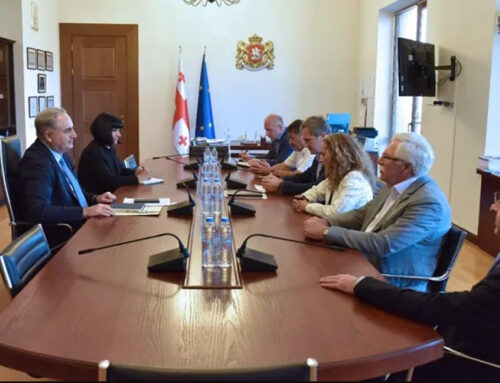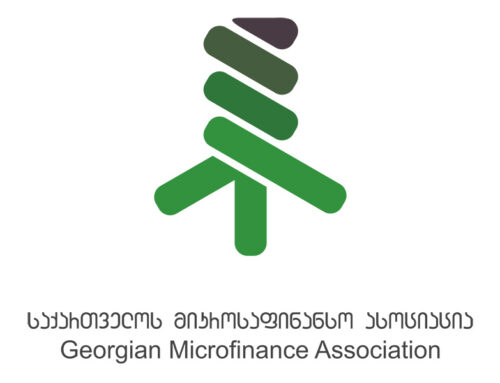On 25th January 2011 The Association of Development and Support of Microfinance Organizations of Georgia held a meeting with the Minister of Agriculture regarding the ten-year credit line funding of the Rural Development Project (RDP). The meeting was attended by The Minister of Agriculture Bakur Kvezereli, Deputy Minister Aleksandre Tsintsadze, The Chairman of the board of Association Aiety Kukava, The executive Director of the Association Iuri Lebanidze, Board member of the Association and the Charirman of the Supervisory board of MFI Crystal Archil Bakuradze, The head of supervisory board of Finagro Giorgi Tchonishvili, the CEO of MFI “Credo” Ljiljana Spasojevic and the deputy chairman Davit Natsvaladze, and the CEO of MFI Alliance Group.
The attendants discussed the project-related problems. The Government of Georgia with the International Development Association and the International Agricultural Development Fund concluded financing agreements of the Rural Development Project (RDP). According to these agreements, the resource of the ten-year credit line was USD 16.2 million with favorable “Libor +” 2 interest rate. And for the commercial banks USD 10.4 million was allocated, while USD 5.8 million was assigned to nonbank institutions (microfinance organizations). The sum mentioned above should be utilized as credits in the rural area until July 1st 2011. Capital resources which remains untapped for this period, will be lost and potentially useful recourses will be distributed among other countries.
The Association of Development and Support of Microfinance Organizations of Georgia has studied the fund utilization issue. Within this project banks have issued 24 credits in the years 2007 – 2008 moreover the banks have not used credit line recourses in 2009 – 2010 , Therefore the USD 4 million remains untapped from the sum allocated for the banks. In addition, in 2009 banks have sent back USD 3.2 million to the projects working capital account. Therefore, the sum amounts to USD 6.5 and it can be used for agricultural lending till July 1, 2011.
Such action is not surprising from the banks side, since the banking institutions in Georgia do not show activity in lending agriculture. December 31, 2010 in the banking sector the agricultural share of loans in total loan portfolio is only a 3% and the same figure amounted to 27.2 % in the case of microfinance organizations. However it should be noted among the 51 MFIs only 11 of them gives credit in the rural areas. According to the complete records commercial banks have issued loans of GEL 47.2 million in the field of agriculture, while microfinance organizations gave loans of GEL 62.2 million as the assets of microfinance organizations is 2.9 % of the commercial banks assets. For the development of agriculture the microfinance organizations have issued loans to 49526 borrowers.
The figures mentioned above indicate the importance of the microfinance institutions in the development of the economy of Georgia. Microfinance sector is the integral part of the credit system and encourages small business development in the city as well as in rural areas. MFI’s are funding small start-up farms and farmers.
Microfinance organizations got involved in the project two years ago. Two years ago five MFIs managed to use more credit recourses regardless the projects limits instead of USD 5.8 million they issued loans of USD 7.3 million in rural areas.
As The utilization of the microfinance loan fund capacity is limited due to the project, on the one hand by the upper limit of USD 2 million and on the other 50 % their own capital, was completely exhausted by the project’s member organizations due to the lending restrictions and parameters.
It was stressed that the loans were issued to business projects as well as farmers and after a year and a half the number of loans amounted to 11323. Considering that the borrowers (farmers and small entrepreneurs) they have families and co-workers as well, at least three more persons have also benefited from the project, consequently turns out that minimum 45.000 persons have benefited from the project which is a quite favorable quantity for our country.
Considering the above-mentioned , the Association asked the Minister of Agriculture to extend the credit limits set by the project and distribute the untapped bank resources on microfinance organizations. In order to maintain the world bank’s cheap credit resources of USD 6.5 million.
From the side of World bank the RDP project coordinator organization representatives agree to our plan. Other microfinance organizations crediting agriculture may get involved in terms of funds utilization. The problem needs timely solution as the project ends in 4 months (June 30, 2011). At this stage additional credit resources for agriculture in order to ensure the upcoming spring works is of high importance.
The Association agreed upon further co-operation with the minister of Agriculture.




